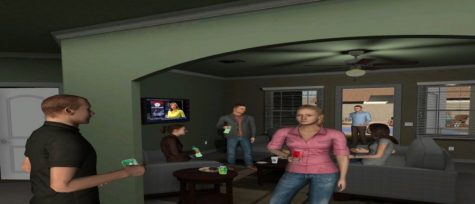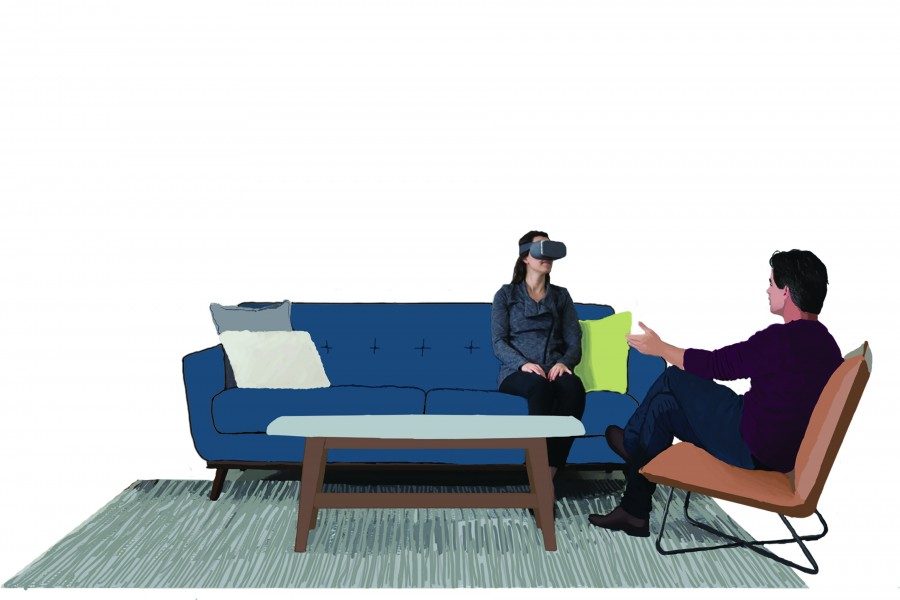Tulane dean expands virtual reality technology to aid those with autism, addiction
Patrick Bordnick, dean of the School of Social Work, brought his 12-year-old daughter into his lab where he was working on virtual reality therapy. To Bordnick’s surprise, he watched as his daughter walked through a virtual party scenario, approaching and engaging with the digital people. His daughter, diagnosed with autism spectrum disorder, often had difficulty with social interactions, but she found ease interacting in the virtual world. This opened up a new realm of application for Bordnick’s VR work.
More than 10 years ago, before virtual reality was a mainstream device, Bordnick wanted to help patients with addiction in ways beyond just the traditional therapy role play.
“You’d role play with a therapist and, see, let’s pretend we’re in a bar, and I’m the bartender and you’re the patient,” Bordnick said. “… What always struck me as sort of odd that the patient looks around the room and it’s a clinical office setting … it’s removed from the context of the situation and that always bothered me.”
By placing patients in a realistic virtual setting, Bordnick found that people can not only feel the cognitive craving, but patients were more likely experience physiological results, like sweaty palms and heart rate conductance. The VR-Δ was created to treat various types of addictions like nicotine, alcohol and other drugs and includes 10-12 scenarios.
When tested in a 10-week scientific study for smoking in which participants were given nicotine replacement therapy and half also received virtual reality skills training, the results found the VR program more effective in reducing the craving to smoke.
“Smoking rates and craving for nicotine were significantly lower for the VRST group compared to NRT-only group at the end of treatment,” the study said. “Self-confidence and coping skills were also significantly higher for the VRST group, and number of cigarettes smoked was significantly lower, compared to the control group at follow-up.”

After seeing his daughter experience the program herself, Bordnick expanded VR-Δ to help autistic people with VR Quality of Life.
“A light bulb went off in my head and said could we use this,” Bordnick said. “… Could we now take some of these environments devoid of drugs or alcohol and create a virtual playground or classroom or places that she would frequent to teach her social and interpersonal skills to improve her quality of life, hence the name of the VR Quality of Life … then I thought we could work with adults that have autism spectrum disorder to teach them job interviewing skills to teach them interpersonal skills as well in different types of setting.”
Bordnick’s work has earned him the Vitality Award for Innovation in Healthcare from Not Impossible Labs, an organization working on “Technology for the Sake of Humanity.” With the award, Bordnick will work with Not Impossible Labs and its partners to expand his work.
“I feel like [he is] doing work that is innovative and fearless,” Joseph Barbarsky, media contact for Not Impossible Labs, said. “That was a sense of fearlessness that we … were looking for, but also that accessibility is a focus that he really prioritizes being able to put this technology on a smartphone and make it accessible to anyone in any walk of life in any situation.”
When the program first started, Bordnick struggled with finding an affordable way to implement the technology, with headsets costing anywhere from $2,000 to $60,000. Since then, Bordnick has made the program compatible with cell phones which can be linked with inexpensive headsets available to buy from Amazon or Google.
With this, patients can not only use the program in therapy but also at home to continue to practice, making the program accessible outside of a clinical setting.
Beyond his application to addiction and autism, Bordnick still continues to look for new ways to expand the use of VR technology.
“What I always like to think … is how do we now take this technology to train and teach our students,” Bordnick said. “So the goal is to have this available for the next generation of therapists … for one to understand relapse and cravings from the patient’s perspective, but also learn how to use them in a therapeutic way and the same thing for working and understanding autism spectrum disorder.”
When Bordnick talks about his work at lectures, he often shares his daughter’s story in hopes of changing people’s views on autism.
“If I were to tell people my daughter has diabetes, people would go, ‘oh okay’ – they don’t say anything,” Bordnick said. “But when you say your daughter has autism or depression or something like that our society still has a lot of stigma … That’s one reason that I do a lot of these interviews about addiction and other behavioral health and mental health conditions is to decrease stigma so it’s no different if you hear the word diabetes versus autism versus heroin dependence.”
Your donation will support the student journalists of Tulane University. Your contribution will allow us to purchase equipment and cover our annual website hosting costs.




Jean Waters • Jan 25, 2018 at 11:44 am
I am quite moved by this article on Mr. Patrick Bordnick, Dean of the School of Social Work. Beginning with bringing his own daughter to his class where he was working on virtual reality therapy and being amazed and surprised watching his daughter who has autism and difficulty in social situations approaching and engaging with virtual digital people. From this positive and encouraging experience he saw happen with his daughter, he made it his goal to spread this Virtual Quality of Life to a broader audience including adults on the autism spectrum teaching them job interviewing skills as well as interpersonal skills and onto other issues that could benefit from this device.. He is the perfect example of how a seed can be planted almost on happenstance and then see it grow and take off to reach heights never imagined.
This is a truly inspiring article that plays against the many many sad, cruel, hopeless situations that get the lead on most media outlets. We all need to see how much goodness there really is all across the world but gets buried under the many cray cray political stories that get top billing for the ratings.